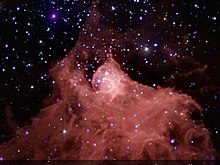(Redirected from List of Star-Forming Regions in the Local Group )
Regions in the Milky Way galaxy and Local Group where new stars are forming
Composite image showing young stars in and around molecular cloud Cepheus B.This is a list of star-forming regions located in the Milky Way Galaxy and in the Local Group . Star formation occurs in molecular clouds which become unstable to gravitational collapse, and these complexes may contain clusters of young stars and regions of ionized gas called H II regions . Stars typically form in groups of many stars, rather than in isolation.
Galactic star-forming regions
Extragalactic star-forming regions
Name
RA
Dec
l
b
Distance
Age
Earliest SpTy
Number of Stars
Cloud Mass
30 Doradus 84.67665
-69.10093
279.4652
-31.6719
49,000
See also
References
Lada, C. J.; Lada, E. A. (2003). "Embedded Clusters in Molecular Clouds". Annual Review of Astronomy & Astrophysics . 41 : 57–115. arXiv :astro-ph/0301540 . Bibcode :2003ARA&A..41...57L . doi :10.1146/annurev.astro.41.011802.094844 . S2CID 16752089 .
^ Shuping, R. Y.; et al. (2012). "Spectral Classification of the Brightest Objects in the Galactic Star-forming Region W40". Astronomical Journal . 144 (4): 116. arXiv :1208.4648 . Bibcode :2012AJ....144..116S . doi :10.1088/0004-6256/144/4/116 . S2CID 119227485 .
Getman, K. V.; et al. (2014). "Age Gradients in the Stellar Populations of Massive Star Forming Regions Based on a New Stellar Chronometer". Astrophysical Journal . 787 (2): 108. arXiv :1403.2741 . Bibcode :2014ApJ...787..108G . doi :10.1088/0004-637X/787/2/108 . S2CID 118626928 .
Kuhn, M. A.; et al. (2010). "A Chandra Observation of the Obscured Star-forming Complex W40". Astrophysical Journal . 725 (2): 2485–2506. arXiv :1010.5434 . Bibcode :2010ApJ...725.2485K . doi :10.1088/0004-637X/725/2/2485 . S2CID 119192761 .
Kuhn, M. A.; Getman, K. V.; Feigelson, E. D. (2015). "The Spatial Structure of Young Stellar Clusters. II. Total Young Stellar Populations". Astrophysical Journal . 802 (1): 60. arXiv :1501.05300 . Bibcode :2015ApJ...802...60K . doi :10.1088/0004-637X/802/1/60 . S2CID 119309858 .
Johnston, K. G.; Shepherd, D. S.; Robitaille, T. P.; Wood, K. (2013). "The standard model of low-mass star formation applied to massive stars: a multi-wavelength picture of AFGL 2591". Astronomy & Astrophysics . 551 : A43, 1–23. arXiv :1212.1719 . Bibcode :2013A&A...551A..43J . doi :10.1051/0004-6361/201219657 . S2CID 54972885 .
Sanna, A.; Reid, M. J.; Carrasco-González, C.; et al. (2012). "Clustered star formation and outflows in AFGL 2591". The Astrophysical Journal . 745 (2): 191–200. arXiv :1111.0843 . Bibcode :2012ApJ...745..191S . doi :10.1088/0004-637X/745/2/191 . S2CID 118465380 .
Zhang, B.; et al. (2013). "Parallaxes for W49N and G048.60+0.02: Distant Star Forming Regions in the Perseus Spiral Arm". Astrophysical Journal . 775 (1): 79. arXiv :1312.3856 . Bibcode :2013ApJ...775...79Z . doi :10.1088/0004-637X/775/1/79 . S2CID 119257313 .
Wu, S.-W.; et al. (2014). "The discovery of a very massive star in W49". Astronomy & Astrophysics . 568 : L13. arXiv :1407.4804 . Bibcode :2014A&A...568L..13W . doi :10.1051/0004-6361/201424154 . S2CID 55277847 .
Sample, Ian (7 January 2020). "Astronomers discover huge gaseous wave holding Milky Way's newest stars" . The Guardian . ISSN 0261-3077 . Retrieved 2020-01-07 – via www.theguardian.com.
External links
Categories :
List of star-forming regions in the Local Group
Add topic
Text is available under the Creative Commons Attribution-ShareAlike License. Additional terms may apply.
**DISCLAIMER** We are not affiliated with Wikipedia, and Cloudflare.
The information presented on this site is for general informational purposes only and does not constitute medical advice.
You should always have a personal consultation with a healthcare professional before making changes to your diet, medication, or exercise routine.
AI helps with the correspondence in our chat.
We participate in an affiliate program. If you buy something through a link, we may earn a commission 💕
↑
